Marcus Shipton says give nuclear a chance
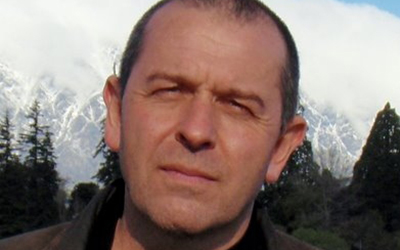
Based on a talk at the Mahurangi Club
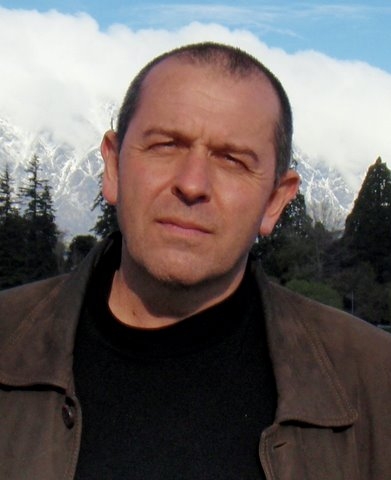
Challenging Dogma: Firm friend of the Mahurangi Marcus Shipton is convinced the world needs nuclear, but not necessarily Aotearoa. image Family album
Isaiah 11:6
And the wolf will dwell with the lamb, And the leopard will lie down with the young goat, And the calf and the young lion and the fatling together; And a little boy will lead them.
I’m not here to convince you Aotearoa needs nuclear power. I honestly don’t know the answer to that question, however I am convinced that the world needs it. The real reason I’m here is to urge you to challenge our dogma, in these challenging times.
First, about my qualifications. I was a late starter, not going to university until 23—less said about the time between leaving school and university the better, suffice to say my recollection was a damn good time was had by all. After completing a degree in biology, I left to make a little bit of money with the intention of returning to do a doctorate in primatology. Instead, I got a job in wastewater and never looked back. After a few years I got the opportunity to study water management at IHE in Delft, completing a diploma, and masters on the influence of nutrients and substratum on the microbial degradation of atrazine.
So in summary, I have absolutely nothing to qualify me to be talking to you about nuclear power.
Huston we have a problem
Big time!
- Environmental degradation
- Atmospheric carbon dioxide
- Water shortage
- Soil loss
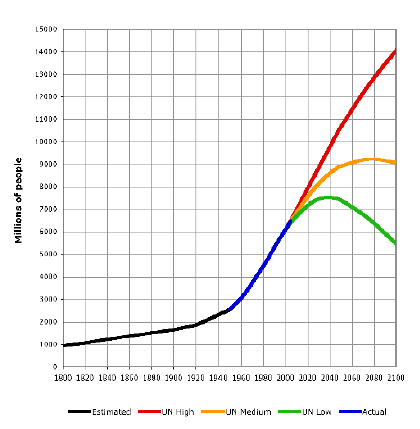
Bets Off Beyond 9 Billion: United Nations population estimates for 2100 range from 5.5 to 14 billion—the prospects of developing sufficient CO2‑free fuel to power the agriculture capable of feeding even the lower figure are poor. Graph Wikipedia
The cause is people—our numbers and our lifestyles. People like you and me.
The world’s population reached six billion in October 1999. It has doubled since 1960, and it is still increasing rapidly—by 77 million a year—and is projected to surpass nine billion by 2050.
Most of the increase will be in the world’s poorest and least-prepared countries.
Food and its link to civilisation
Food scarcity and the resulting higher food prices is pushing poor countries into chaos. Such ‘failed states’ can export disease, terrorism, illicit drugs, weapons and refugees.
Water shortages, soil losses and rising temperatures from global warming are placing severe limits on food production.
Without massive and rapid intervention to address these three environmental factors, a series of government collapses could threaten the world order.
Food and its link to fossil fuel
The energy ratio (energy out, energy in) in agriculture has decreased from being close to 100% for traditional pre-industrial societies to less than 1% in most cases in the present food system, as energy inputs, mainly in the form of fossil fuels, have gradually increased.
Commercial food production is oil-powered. Most pesticides are petroleum-based, and all commercial fertilisers are ammonia-based. Ammonia is produced from natural gas.
Oil-based agriculture is primarily responsible for the world’s population exploding from one billion at the middle of the 19th century to 6.3 billion at the turn of the 21st. Oil allowed for farming implements such as tractors, food storage systems such as refrigerators, and food transport systems such as trucks.
Following the peak in oil production, food supplies all over the world will begin to be disrupted, not only by price increases but by increasing oil shortages.
Are we going to be good neighbours? Are we going to be leaders? Albert Szent-Györgyi:
I am deeply moved if I see one man suffering and would risk my life for him. Then I talk impersonally about the possible pulverization of our big cities, with a hundred million dead. I am unable to multiply one man’s suffering by a hundred million.
Energy 101
Burning the simplest fossil fuel, methane, produces water, carbon dioxide and heat
CH4 + 2 O2 = 2 H2O + CO2 + Energy
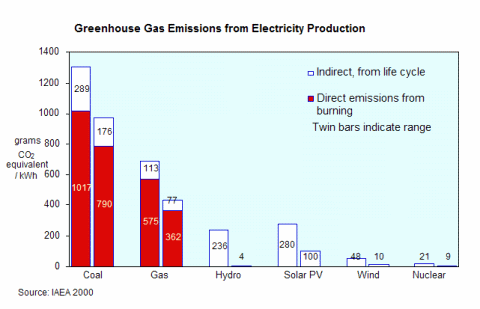
King of the Carbon Hill: Small wonder Dr James Hansen is urging the rapid phasing out of coal and urgent consideration of fourth-generation nuclear. chart World Nuclear Association
The chemistry of burning coal is more complex, but the carbon dioxide is an inescapable and ruinous by-product. Additional atmospheric carbon dioxide reflects back additional infrared heat from the surface of the Earth—heat that would otherwise escape harmlessly into space.
Alternatively, burning a ton of thorium could produce the same energy as 3.5 million tons of coal—without the 6.4 million tons of carbon dioxide.
Renewables
While solar power is relatively expensive, and wind is limited in its implementation, both have a highly important role in renewable electricity generation.
Unfortunately, even granting considerable advances in technology and efficiency of both technologies, neither has the potential to become a primary source of electricity because of their intermittent nature. Neither could ever be relied upon to meet baseload supply.
Thorium the wonder fuel
What if we could build a nuclear reactor that
- offered no possibility of a meltdown
- generated its power inexpensively
- created no weapons-grade by-products
and the waste of which was radioactive for a few hundreds rather than tens of thousands years?
Thorium is a slightly radioactive metal much more abundant than uranium—just how abundant is not well agreed, because of the very low value placed upon it. Australian science writer Tim Dean describes its properties:
First of all, unlike uranium-235 and plutonium-239, thorium is not fissile, so no matter how much thorium you pack together, it will not start splitting atoms and blow up. This is because it cannot undergo nuclear fission by itself and it cannot sustain a nuclear chain reaction once one starts. It’s a wannabe atom splitter incapable of taking the grand title.
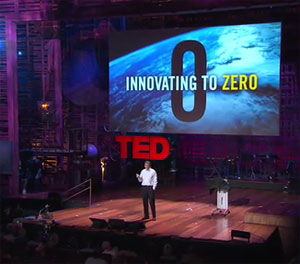
The Other 18-Minute Talk: Bill Gates’ TED Conference talk stressed the need for cheap zero-CO2 energy, including fourth-generation nuclear, in the interests of the planet’s two billion poorest—his ‘one wish’. image International Thorium Energy Organisation
And its nuclear ‘waste’ potential:
Add plutonium to the mix—or any other radioactive actinide—and the thorium fuel process will actually incinerate these elements. That’s right: it will chew up old nuclear waste as part of the power-generation process. It could not only generate power, but also act as a waste disposal plant for some of humanity’s most heinous toxic waste.
This, Dean says, is especially significant when it comes to plutonium, which is particularly difficult to dispose of.
Conclusion
I have tried to create a sense of urgency while, hopefully, not crushing hope.
My reason for creating the urgency is to persuade you that dogma has no place when contemplating our future. For better or for worse, the world’s food supply depends on energy. We face a future where boldness and open-mindedness are going to be essential for civilisation to be maintained.
Aptly, thorium is named for Thor: The hammer-wielding god associated with thunder, lightning, storms, oak trees, strength, destruction, fertility, healing, and the protection of mankind. But it is thorium reactors that present a quantum leap forward. Humble thorium could potentially alleviate three of the most pressing issues facing modern civilisation in the 21st century:
- The hunger for energy
- The spectre of climate change
- The need to eliminate nuclear weapons.
Swords into ploughshares.
Principal sources This piece draws directly from two particular sources: New Age Nuclear, Tim Dean Cosmos; and Why Our Food is So Dependent on Oil, Norman Church Energy Bulletin.
Further reading Sustainable Energy – without the hot air, specifically page 166, Thorium.
